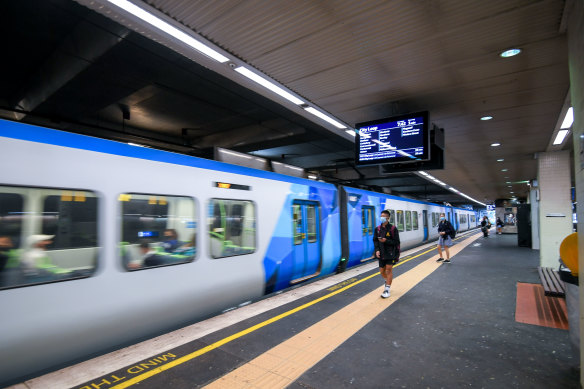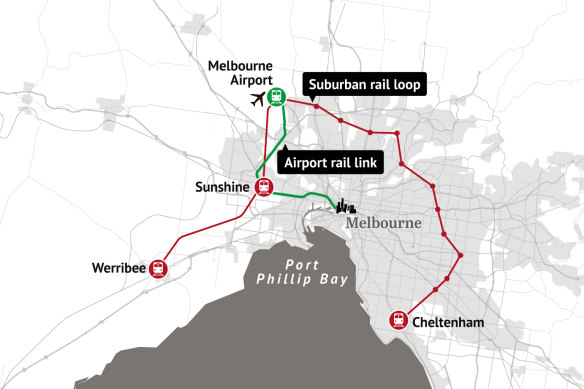This was published 3 years ago
Opinion
Suburban Rail Loop’s latest woes another reason to hit pause
Marion Terrill
Transport and cities program director at Grattan InstituteIt was with great fanfare that the Andrews government announced the Suburban Rail Loop three months out from the 2018 election, but there have been red flags on the track ever since.
The latest problem is poor integration of proposed new stations with existing ones at Glen Waverley, Box Hill and Cheltenham. Local mayors want a rethink, so commuters won’t have to exit one station to enter the other, and to keep the distances short.

Commuters face a disjointed connection between Box Hill station (pictured) and the new loop line.Credit: Eddie Jim
The government calls the Suburban Rail Loop “city-shaping” and argues we need it to complement the hub-and-spoke train system that takes passengers into the CBD. It sounds like a good idea, but there has been a litany of problems.
The mayors are right: the project needs a rethink – not just stations, but lock, stock and barrel.
The Suburban Rail Loop is a 90-kilometre passenger rail line that will arc around the city, from Cheltenham, through the eastern and northern suburbs, to the airport and around to Werribee. The sections from Cheltenham to the airport are scheduled for completion several decades from now, at a cost somewhere between $30 billion and $50 billion. It’s the largest public transport project ever to get going in Australia.
Suburban Rail Loop is not only the largest, but also one of the least scrutinised projects in recent Australian history. The project did not appear on Infrastructure Australia’s priority list. It wasn’t in the state government’s ‘Plan Melbourne’ blueprint. Infrastructure Victoria did not recommend the project and was not consulted before the government’s announcement. Neither was cabinet, nor the Department of Transport. Instead, the project had been worked on by Development Victoria, reportedly with the knowledge of only four ministers.

The Andrews government’s planned Suburban Rail Loop.Credit:
It still hasn’t made it to even the most preliminary stage of Infrastructure Australia’s priority list, but that didn’t stop Anthony Albanese, in the heat of the recent election campaign, from promising $2.2 billion of federal government money for the project.
This project is riddled with risk. Grattan Institute research shows that bigger projects are riskier projects; projects with first-announced costs of more than a billion dollars have a cost overrun almost half of the time, and the average increase in costs is 30 per cent. And if the project is announced close to an election, the average cost overrun is 23 per higher than for similar projects announced at other times.
It’s true that public transport in Melbourne is patchy once you get away from the centre, and some outer areas are poorly served. The difficulty is scale: the suburbs just aren’t like the CBD. For heavy rail to compete with driving, there need to be frequent services and competitive trip times. And that requires large numbers of people travelling from a small number of origins to a small number of destinations.
But the 15 suburbs that will get a new station only have about 10 per cent of Melbourne’s jobs between them, and those jobs are dispersed throughout the suburb rather than concentrated the way they are in the CBD. Most of the suburbs getting a new rail station already have one on the current network – and that hasn’t transformed them into jobs hotspots.
Supporters of the Loop may say that if we had insisted on a careful process we wouldn’t have built the Sydney Opera House, and that the Suburban Rail Loop, too, will be transformative. The problem is, though, that there’s an infinite number of projects that could be transformative, and in the end, we need to choose with our eyes open.
To hit up every inhabitant of Melbourne for somewhere between $6000 and $12,000 just for the Cheltenham to the airport sections is a decision that should not be taken without the utmost due diligence.
In suburban areas, most people drive. That’s even more true post-pandemic, where people have shunned public transport due to an understandable fear of catching COVID.
And now we’re facing a time of high uncertainty; we simply don’t know which of our new patterns of work and travel will become permanent, and it’s a brave person who would say all the projects conceived pre-COVID are the right ones for a changed world.
NSW is slowing down its major projects, recognising that there’s just too much going on, and the tight market for engineering construction is pushing up prices. Victoria should follow suit.
We don’t have a good process for cancelling projects that turn out to be less attractive than they might have once seemed, but the mayors are right in calling for, at a minimum, a pause and a rethink.